Discover the secrets to growing and caring for the unique and eye-catching Staghorn Fern. This complete guide covers everything from mounting to watering and more.
Are you seeking to add a touch of tropical flair to your indoor or outdoor space? Look no further than the captivating staghorn fern! With its striking, antler-like fronds and verdant green foliage, this unique plant is sure to be a conversation starter. Staghorn ferns may seem intimidating at first, but with the right care and attention, they can thrive and become a stunning addition to your home or garden.
In this comprehensive guide, we’ll delve into the world of staghorn ferns, covering everything from their origins and varieties to the essential steps for successful growth and care. Whether you’re a seasoned plant enthusiast or a curious beginner, this article will equip you with the knowledge and tips you need to cultivate a lush and healthy staghorn fern.
What is a Staghorn Fern?

Here’s a short information chart for the Staghorn Fern:
| Attribute | Information |
|---|---|
| Botanical Name | Platycerium spp. |
| Plant Type | Epiphytic fern |
| Soil Type | Epiphytic, often grown mounted on boards or in baskets with sphagnum moss |
| Color Varieties | Green foliage |
| Zones | 9-12 (USDA Hardiness Zones) |
| Exposure | Bright, indirect light to partial shade |
| Bloom Time | Non-flowering |
| Height/Spread | 2-3 feet tall / 2-3 feet wide |
The staghorn fern, scientifically known as Platycerium, is an epiphytic fern belonging to the Polypodiaceae family. Unlike typical ferns that grow in soil, staghorn ferns are unique in that they naturally grow on the bark of trees or rocks, deriving their nutrients and moisture from the air and accumulated debris.
Native to tropical and subtropical regions of Africa, Australia, and Southeast Asia, staghorn ferns have adapted to thrive in warm, humid environments. Their distinctive fronds, resembling the antlers of a stag, are made up of two types: fertile fronds, which produce spores and sterile fronds, which serve as the plant’s “foliage.”
Common Staghorn Fern Varieties
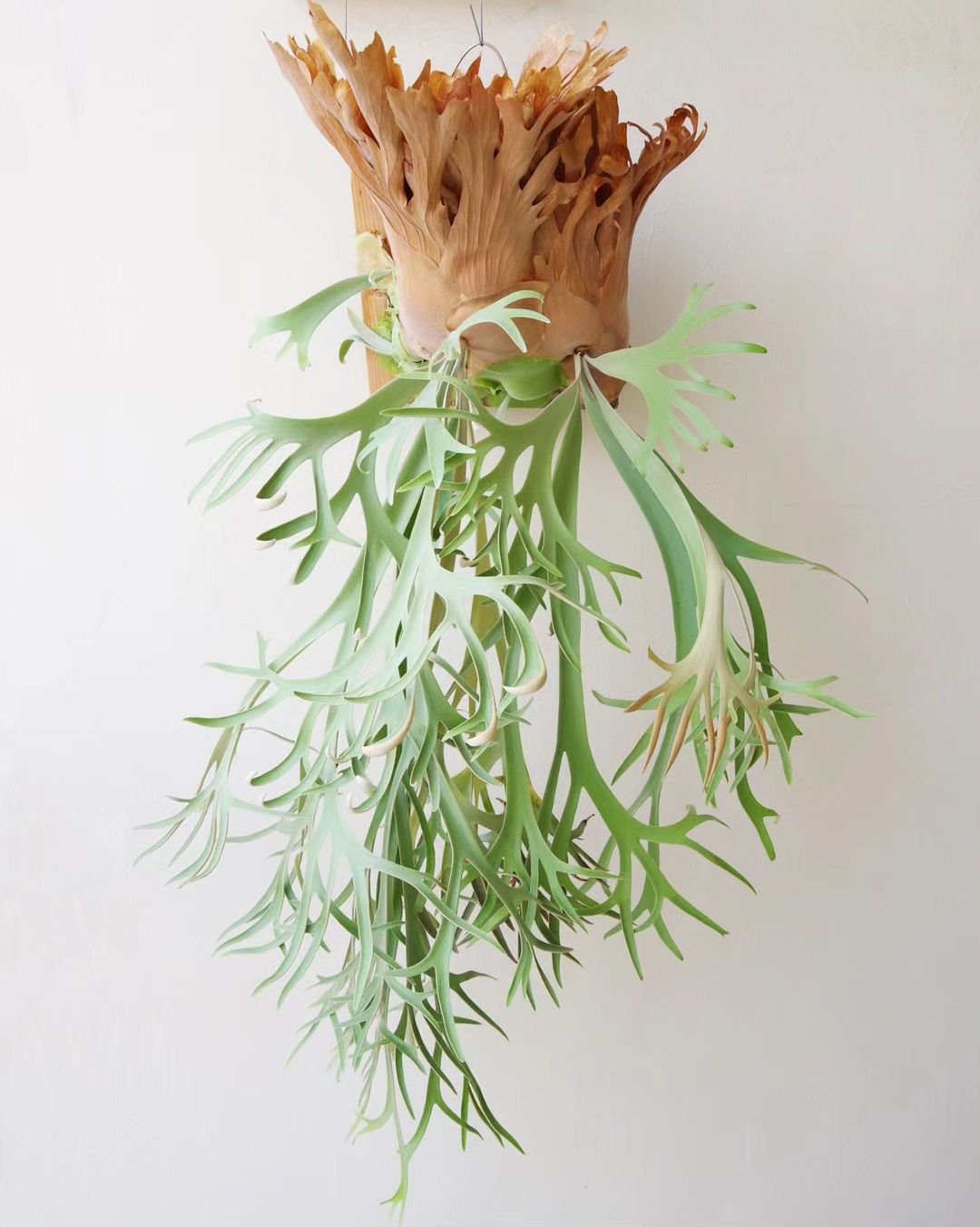
There are several species and cultivars of staghorn ferns, each with its own unique characteristics and growth habits. Here are some of the most popular varieties:
- Platycerium bifurcatum (Elkhorn Fern)
- Platycerium superbum (Australian Staghorn Fern)
- Platycerium andinum (South American Staghorn Fern)
- Platycerium coronarium (Antler Fern)
While they share many care requirements, each variety may have slightly different preferences, so it’s essential to research the specific needs of your chosen staghorn fern.
Growing and Caring for Staghorn Ferns
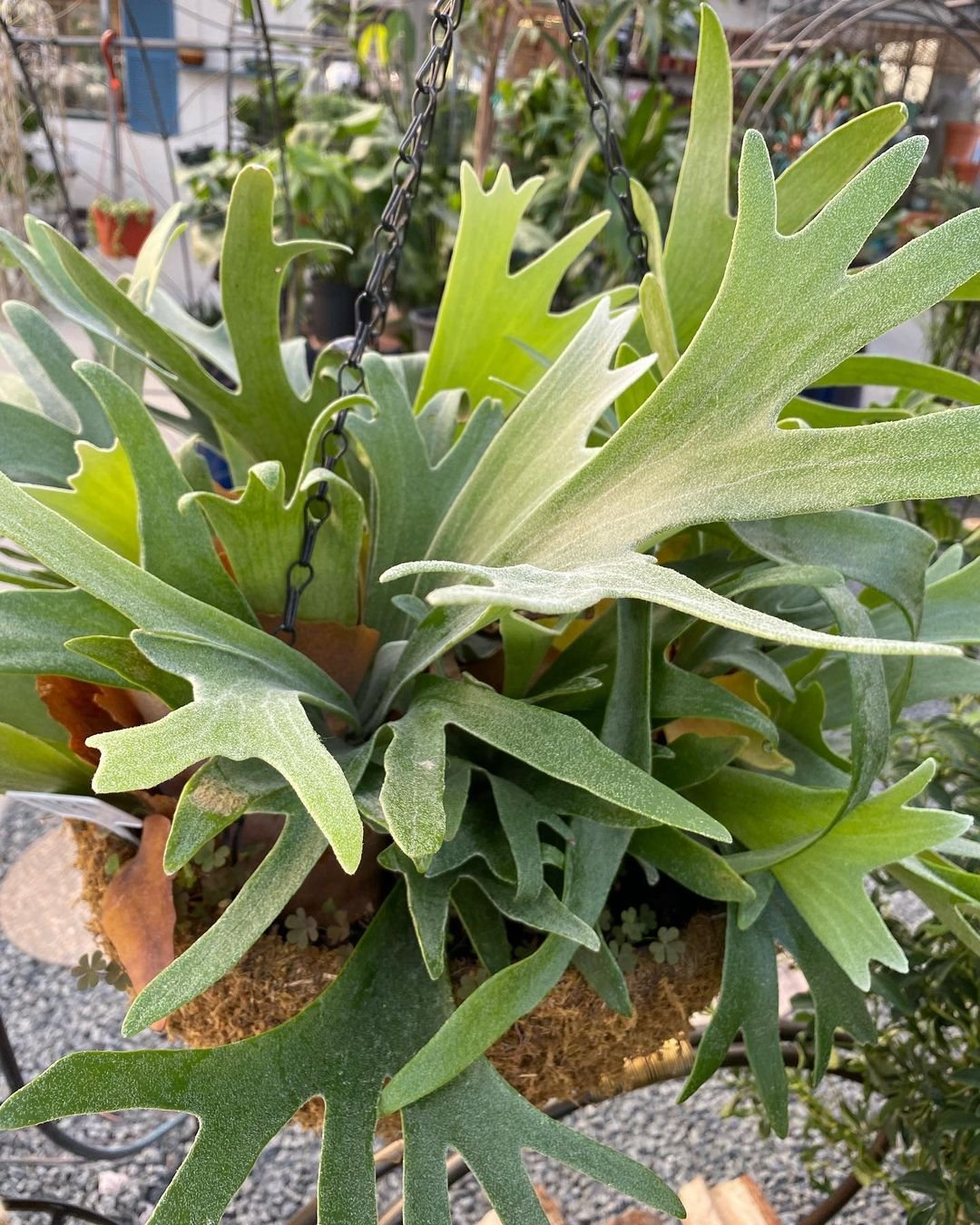
Mounting
One of the unique aspects of staghorn ferns is their preference for growing mounted on a surface rather than in traditional soil. This replicates their natural habitat of growing on trees or rocks. There are several mounting options to choose from:
- Wood Plaques or Boards: Untreated wood, like cedar or redwood, makes an excellent mounting surface for staghorn ferns.
- Wire Baskets: Hang wire baskets filled with a suitable growing medium to create a hanging staghorn fern display.
- Tree Trunks or Logs: For outdoor staghorn ferns, you can mount them directly onto the bark of a tree or a sturdy, moisture-resistant log.
To mount your staghorn fern, use a wire, fishing line or specialized staghorn fern mounting plates to secure the plant to the chosen surface. The growing medium should be a well-draining mixture of materials like sphagnum moss, bark chips or coconut fiber.
Light Requirements

Staghorn ferns thrive in bright, indirect light, mimicking their natural habitat under the canopy of trees. Here are some guidelines for providing the right light conditions:
- Indoor staghorn ferns: Place them near an east or west-facing window, where they’ll receive plenty of bright, filtered light. Avoid direct sunlight, which can scorch the fronds.
- Outdoor staghorn ferns: Choose a location with dappled shade, such as under a tree or on a covered patio or porch. Protect them from intense, direct sunlight.
If your staghorn fern isn’t receiving enough light, its fronds may become leggy or lose their vibrant green color. Too much direct sun, on the other hand, can cause the fronds to turn yellow or brown and become dry and crispy.
Watering
Proper watering is crucial for the health and growth of your staghorn fern. These plants prefer their growing medium to be consistently moist but not waterlogged. Here are some tips for watering:
- Immerse the entire mounting surface and growing medium in water for several minutes, allowing it to fully saturate. This can be done in a sink, bucket, or even a bathtub for larger specimens.
- Alternatively, you can use a hose or watering can to thoroughly soak the growing medium until water runs through the drainage holes or out the bottom of the mount.
- Avoid letting the growing medium dry out completely between watering, as this can stress the plant and cause it to lose its lush appearance.
- During hot, dry periods, you may need to water more frequently to maintain the appropriate moisture levels.
It’s important to note that staghorn ferns are sensitive to mineral buildup and chemicals found in some water sources. If possible, use distilled water, rainwater, or allow tap water to sit for 24 hours before using it to allow any chlorine or other chemicals to dissipate.
Humidity

As tropical plants, staghorn ferns thrive in high humidity environments. Aim for a humidity level of at least 50%, but ideally between 60% and 80%. Here are some ways to increase humidity for your staghorn fern:
- Use a room humidifier, especially during dry seasons or in heated indoor environments.
- Mist the fronds regularly with a spray bottle filled with room temperature water.
- Group your staghorn fern with other plants, as they will create a more humid microclimate.
- Place the mounted fern on a tray filled with pebbles and water, allowing the evaporating water to increase the surrounding humidity.
Low humidity can cause the fronds to turn brown and crispy, eventually leading to the plant’s decline. Maintaining proper humidity levels is essential for keeping your staghorn fern happy and healthy.
Fertilizing
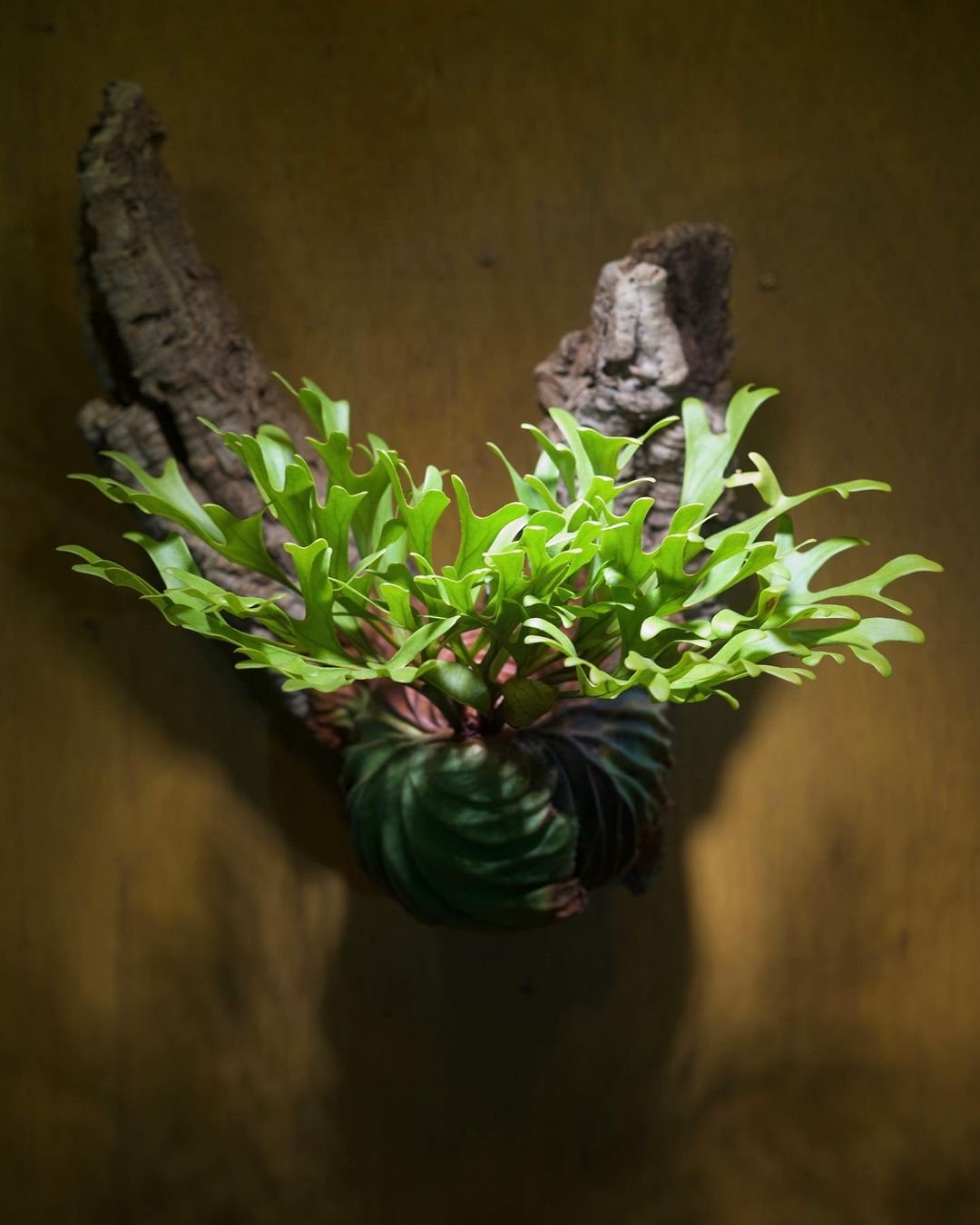
Staghorn ferns are relatively light feeders but still benefit from occasional fertilizing during their active growing season (spring and summer). Here are some tips for fertilizing:
- Use a balanced, water-soluble fertilizer diluted to half strength, or a slow-release fertilizer formulated for ferns and epiphytic plants.
- Apply the fertilizer to the growing medium, taking care not to get any on the fronds, as this can cause burning or discoloration.
- Fertilize every 4 to 6 weeks during the growing season, and avoid fertilizing in the winter when growth slows down.
Over-fertilizing can lead to salt buildup and potential root damage, so it’s essential to follow the product instructions carefully and not over-apply.
Pruning and Grooming
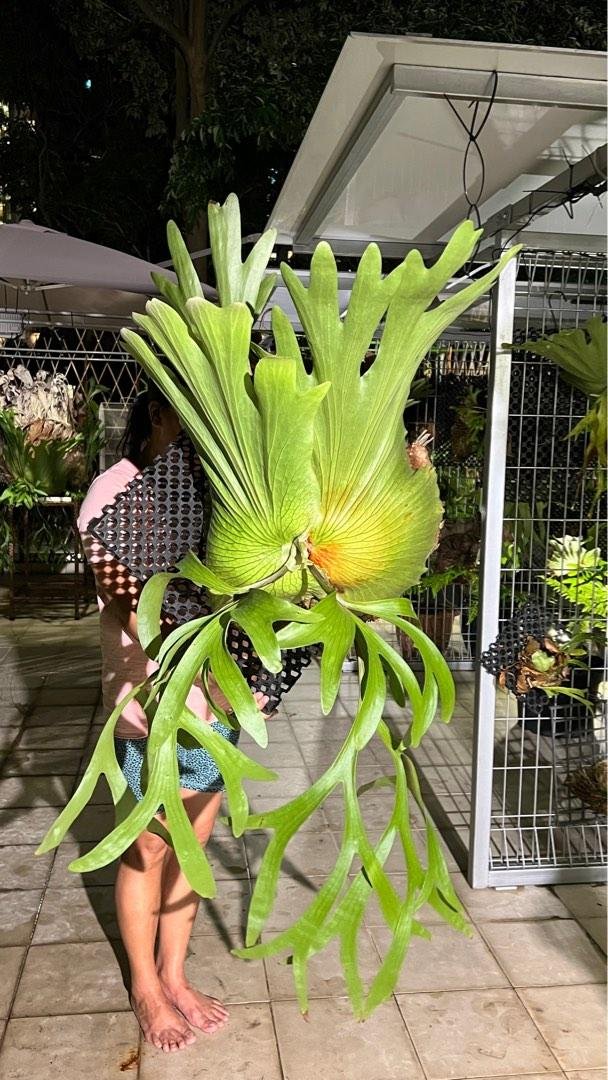
Regular pruning and grooming can help maintain the attractive appearance of your staghorn fern while promoting healthy growth. Here are some tips:
- Remove any dead, damaged, or discolored fronds by cutting them off at the base of the plant using clean, sharp pruning shears.
- Trim away any stray or untidy growth to maintain the desired shape and overall appearance of the fern.
- Gently clean the fronds with a soft brush or damp cloth to remove any dust or debris buildup.
Proper grooming not only enhances the aesthetic appeal of your staghorn fern but also improves air circulation and allows the plant to focus its energy on new growth.
Repotting and Propagation (Continued)

Staghorn ferns can also be propagated by division or through the use of their plantlets (also known as pups or offsets). Here’s how:
Propagation by Division
- Carefully remove the mature staghorn fern from its mount, taking care not to damage the root system or fronds.
- Gently divide the plant into smaller sections, ensuring each division has a portion of the root system and at least one set of fronds.
- Prepare new mounting surfaces or containers with fresh growing medium.
- Secure each division to its new mount using wire, fishing line, or mounting plates.
- Water thoroughly and place the newly propagated ferns in a warm, humid environment until they become established.
Propagation by Plantlets
- Look for small plantlets or offsets growing from the base of the mother plant.
- Carefully remove these plantlets by gently twisting or cutting them off, leaving a small portion of the stem attached.
- Prepare a new mounting surface or container with fresh growing medium.
- Place the plantlet on the mounting surface and secure it in place using wire, fishing line, or mounting plates.
- Water thoroughly and keep the propagated plantlet in a warm, humid environment until it establishes its own root system and begins to grow.
Proper timing and care during the propagation process are essential to ensure the successful establishment of new staghorn fern plants.
Common Problems and Solutions
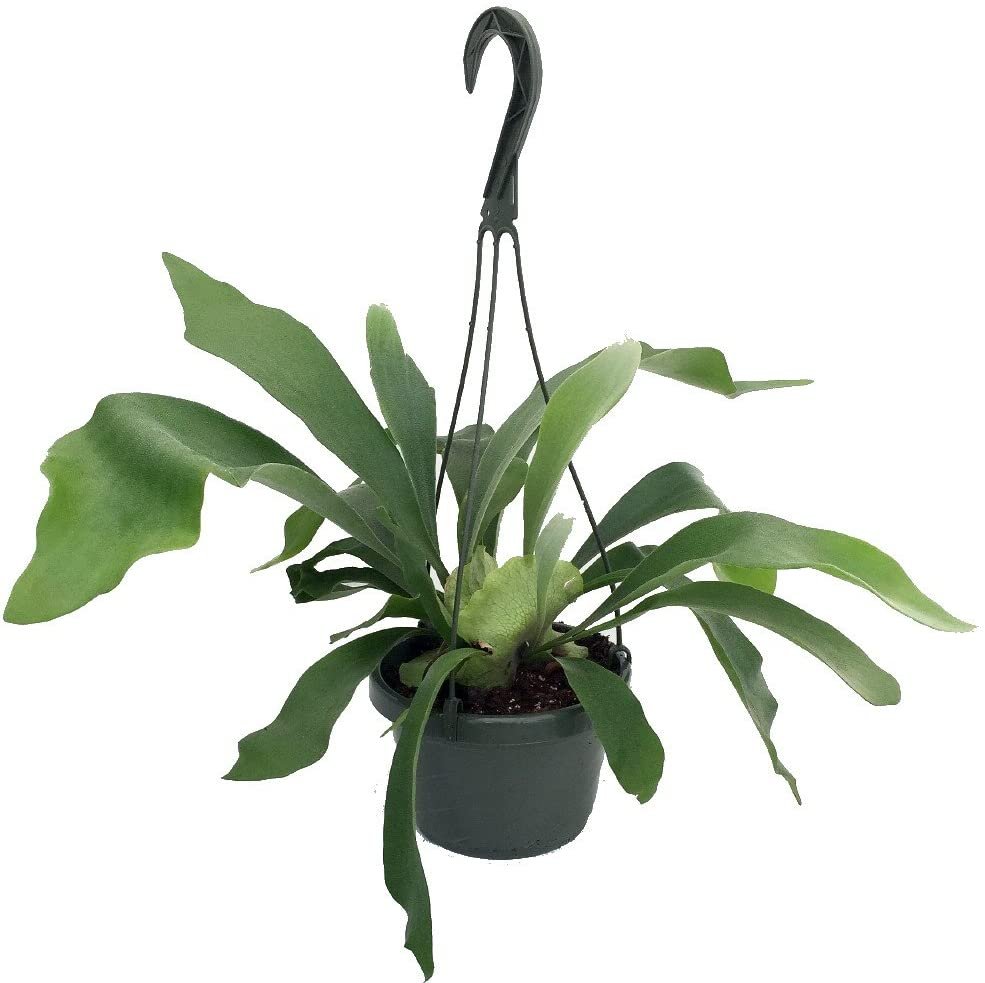
Even with proper care, staghorn ferns can sometimes encounter issues. Here are some common problems and their solutions:
Browning or Yellowing Fronds
Possible causes:
- Lack of humidity
- Too much direct sunlight
- Underwatering or overwatering
Solutions:
- Increase humidity levels around the plant by using a humidifier, misting regularly, or placing the fern on a tray filled with pebbles and water.
- Relocate the fern to a spot with bright, indirect light and away from direct sunlight.
- Adjust your watering schedule to ensure the growing medium is consistently moist but not waterlogged.
Frond Wilting or Curling
Possible causes:
- Low humidity
- Underwatering
- Salt buildup in the growing medium
Solutions:
- Increase humidity levels around the plant.
- Water the fern more frequently, ensuring the growing medium stays consistently moist.
- Leach the growing medium by flushing it with distilled water or rainwater to remove any excess salts or minerals that may have built up.
Stunted Growth or Lack of New Fronds
Possible causes:
- Nutrient deficiency
- Inadequate light
- Root-bound conditions
Solutions:
- Fertilize the fern during the growing season with a balanced, water-soluble fertilizer or a slow-release fertilizer formulated for ferns and epiphytic plants.
- Ensure the fern is receiving bright, indirect light. Supplement with grow lights if necessary.
- Repot or remount the fern in a larger mounting surface or container with fresh growing medium if the roots appear to be pot-bound.
Pests and Diseases
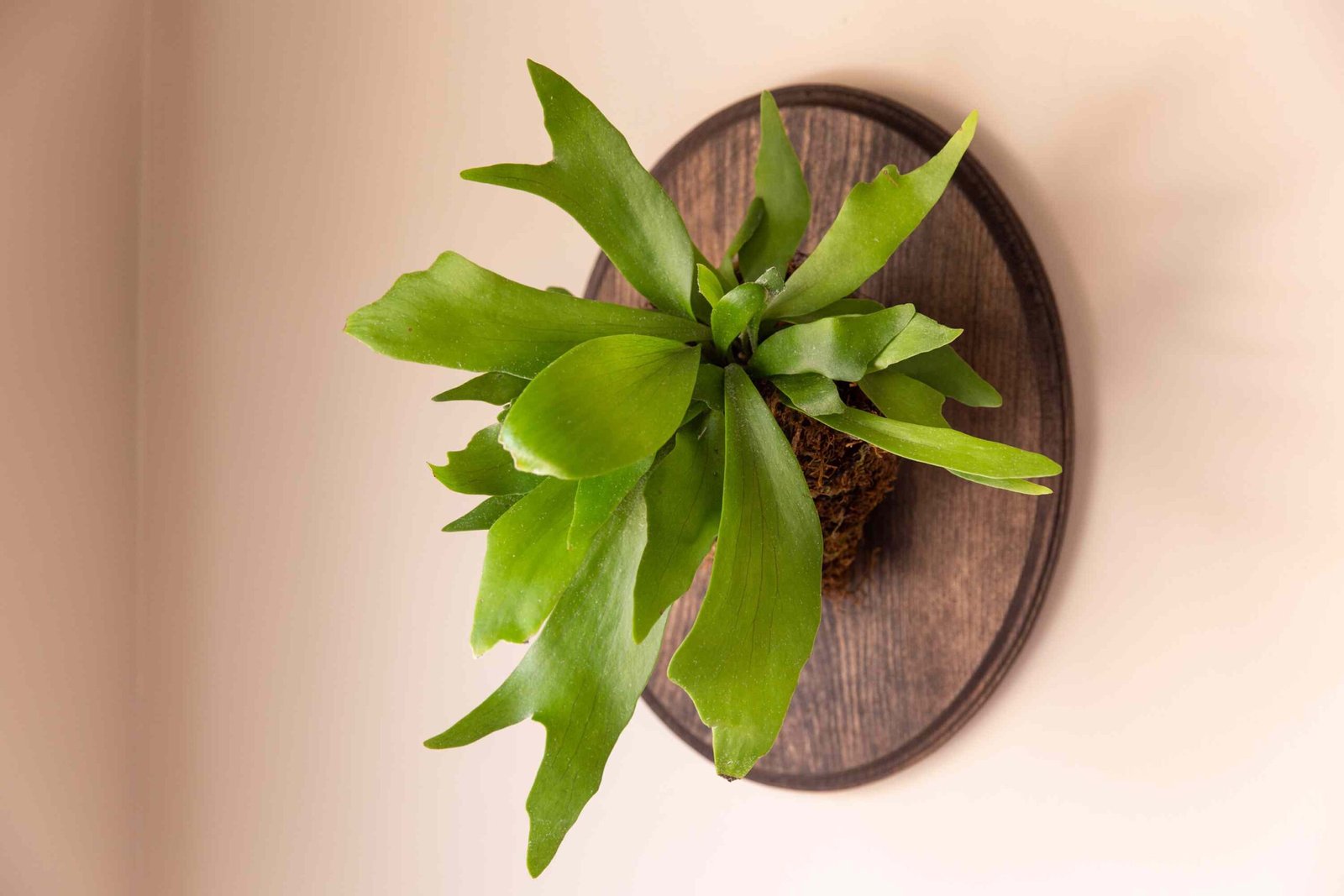
Staghorn ferns can be susceptible to various pests and diseases, including:
- Spider mites
- Mealybugs
- Scale insects
- Fungal diseases like leaf spot or rust
Solutions:
- Regularly inspect your fern for signs of pests or diseases and take prompt action if any are detected.
- Treat pest infestations with appropriate insecticidal soap, horticultural oil, or neem oil, following the product instructions carefully.
- Remove and destroy any severely affected fronds or plants to prevent the spread of diseases.
- Maintain proper growing conditions, as stressed plants are more susceptible to pests and diseases.
Conclusion
Growing and caring for a staghorn fern can be a rewarding and visually stunning experience. With their unique appearance and tropical flair, these epiphytic ferns can make a statement in any indoor or outdoor space. By following the guidance outlined in this comprehensive guide, you’ll be well-equipped to provide the proper mounting, light, water, humidity, and care your staghorn fern needs to thrive.
Remember, staghorn ferns are resilient plants, but they do have specific requirements that must be met to maintain their lush, vibrant appearance. Patience, attentiveness, and a willingness to make adjustments are key to successfully cultivating these captivating ferns.
Embrace the joy of nurturing these unique plants and enjoy the breathtaking beauty they bring to your environment. With proper care and attention, your staghorn fern can be a stunning and long-lasting addition to your indoor or outdoor oasis for years to come.